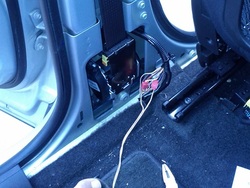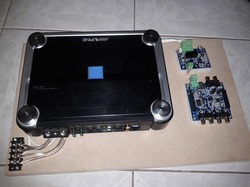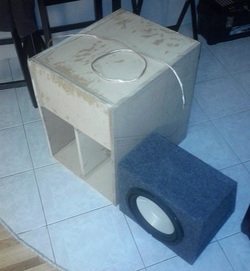Autotuba - a folded horn subwoofer
A horn loudspeaker is a loudspeaker which uses a horn structure to increase the overall efficiency of the driving element (speaker, or in this case, a sub-woofer driver). Horns have special qualities, which makes them very attractive for use in car audio setup:
Since there's no such thing as a free lunch, horns do have disadvantages:
With the right design, an inexpensive, well performing horn sub-woofer can be built: Autotuba (AT), by Bill Fitzmaurice. It comes with 2 variants: regular and tall. Regular is longer and shorter, while tall... is shorter, but taller. I have built 2, one regular for my wife's SUV, and tall one for my sedan.
Plans for the design are available at a very reasonable cost on Bill's site. There are many free plans available on DIY audio websites, such as diyaudio.com and diymobileaudio.com
The least expensive recommended driver for the tuba is about $35, wood will cost another $35, misc hardware and glue $20. Designate few afternoons for building it, and you can have a very well performing subwoofer for under $100.
After building one regular and one tall AT, I decided to install regular in my wife's SUV, and the tall one in my sedan.
- lower distortion resulting in cleaner, more natural sound and less locatable bass
- increased driver efficiency, allowing to have a decent output with lower power amplifier requirement
- faster transient response
Since there's no such thing as a free lunch, horns do have disadvantages:
- bigger in size
- more complex to build, requiring more material and many angled cuts
- less tolerant to construction errors
With the right design, an inexpensive, well performing horn sub-woofer can be built: Autotuba (AT), by Bill Fitzmaurice. It comes with 2 variants: regular and tall. Regular is longer and shorter, while tall... is shorter, but taller. I have built 2, one regular for my wife's SUV, and tall one for my sedan.
Plans for the design are available at a very reasonable cost on Bill's site. There are many free plans available on DIY audio websites, such as diyaudio.com and diymobileaudio.com
The least expensive recommended driver for the tuba is about $35, wood will cost another $35, misc hardware and glue $20. Designate few afternoons for building it, and you can have a very well performing subwoofer for under $100.
After building one regular and one tall AT, I decided to install regular in my wife's SUV, and the tall one in my sedan.
SUV installation

I have tapped into rear speaker outputs of the factory radio. Since the SUV has an active noise cancellation system, which uses front speakers, I did not have much choice. Power for the amplifier is taken from rear accessory outlet, rated at 20A, to supply Alpine MRP-F450. I am using one high level input and one channel only. It is enough to have the bass overpower factory stereo. Wife is overall happy with the setup. AT is taking almost 30% of the cargo space. It is lacking a bit in the 1st octave, but she does not seem to mind it at all. I do.
Sedan Installation

After installing the AT in the SUV, I had to build one in my car. Since AT lacks in the 1st octave, I decided to add miniDSP to boost that frequency range and attenuate peaks caused by standing waves. I am also using a more powerful amplifier, 2 bridged channels of Alpine PDX 4.150. I have also tapped into rear speakers, however I am using level converter to feed the signal into DSP, then to the amp. Power is taken from the fuse box, using 2 tapped fuse adapters, each rated at 10A. Having a 600W car sub-woofer system before, I can verify AT matches it in output, and outperforms in quality, without the annoying dimming lights, while using only a 1/4th of the power. miniDSP is powered via miniDC isolator.
Listening impressions

I was amazed how much output can be obtained from AT with so little power fed to it. Very clean bass, fast transient response, low harmonics. It sounds like all the bass is coming from the front speakers.
Lower half of the 1st octave is not as not as loud as I'd like, but at the same time, there's less cabin panel rattle.
Not as much audible from the outside of the car as sealed boxes. Well worth the extra effort spent on building it.
Picture shows size difference between Tall AT and a 10" Sealed sub. When providing both with 100W, AT dominates over 10" sub in terms of output and clarity.
Lower half of the 1st octave is not as not as loud as I'd like, but at the same time, there's less cabin panel rattle.
Not as much audible from the outside of the car as sealed boxes. Well worth the extra effort spent on building it.
Picture shows size difference between Tall AT and a 10" Sealed sub. When providing both with 100W, AT dominates over 10" sub in terms of output and clarity.
